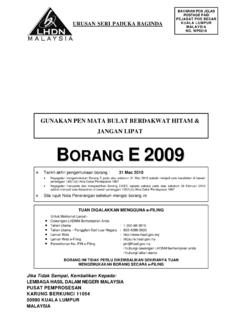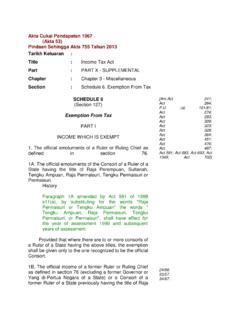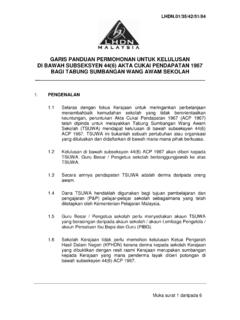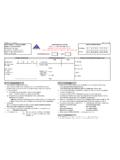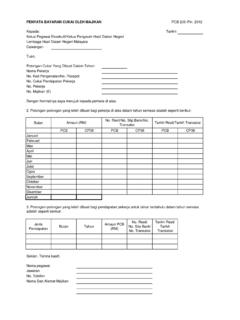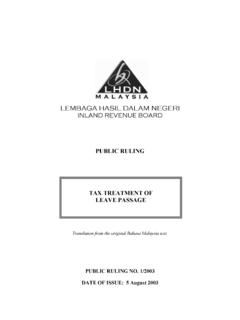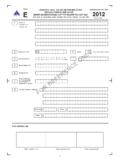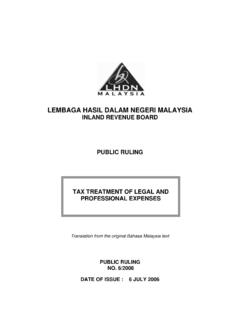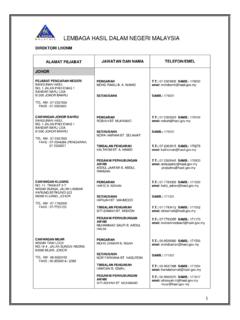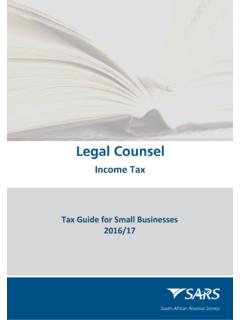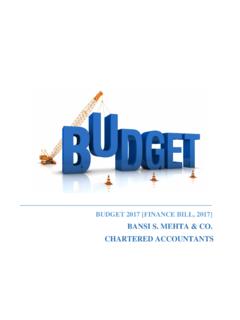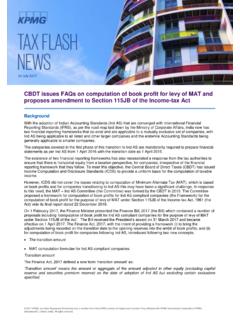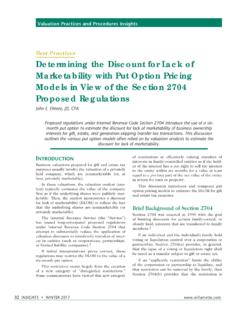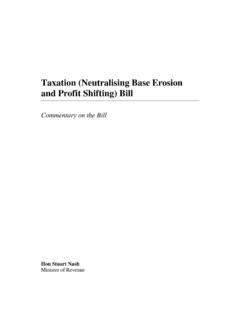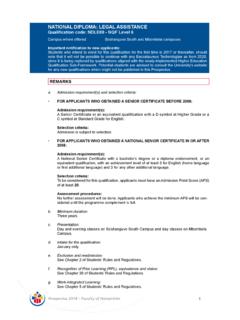Transcription of Common Reporting Standard (CRS) Guidance Notes
1 Common Reporting Standard (CRS). Guidance Notes 5 February 2018. Compliance Requirements for Income Tax (Automatic Exchange of Financial Account Information) Rules 2016. &. Income Tax (Automatic Exchange of Financial Account Information) (Amendment) Rules 2017. &. Labuan Business Activity Tax (Automatic Exchange of Financial Account Information) Regulations 2018. This is not a legal document. Whilst every effort is made to ensure that the information given in this guide is accurate, the Government of Malaysia should not be held responsible for any liability incurred or loss suffered, including without limitation, special, indirect, or consequential arising out of or related to the use or reliance of the information contained in it, whether by action in contract or tort or otherwise how so ever. ii Table of Contents 1. Objective .. 1. 2. Background.
2 1. 3. Effective implementation .. 2. 4. Exchanging of CRS information .. 2. Mechanism .. 2. List of jurisdictions that Malaysia will exchange the CRS information 2. 5. Implementation Timelines .. 3. General provision .. 3. Special provision for Pre-existing Individual Account .. 4. 6. Financial Institutions .. 4. Overview .. 4. Related Entities .. 5. Custodial Institutions .. 5. Depository Institutions .. 6. Investment Entities .. 7. Collective Investment Schemes (CIS) .. 8. Non-Participating Jurisdictions Investment Entities .. 9. Fund Distributors .. 10. Advisory-only Distributors .. 10. Specified Insurance Companies .. 11. 7. Non-Financial Entities (NFEs) .. 11. Overview .. 11. Active 12. Passive Income .. 13. Passive NFEs .. 14. 8. Non- Reporting Malaysian Financial Institutions .. 14. Overview .. 14. Governmental Entities .. 15. International 15.
3 Central 16. Broad Participation Retirement Fund .. 16. iii Narrow Participation Retirement Fund .. 17. Pension Funds of Government Entities, International Organisations or Central Banks .. 17. Qualified Credit Card Issuers .. 17. Other Low Risk Entities Defined in Domestic Law .. 18. Exempt Collective Investment Vehicles .. 18. Trust where the Trustee is a Reporting FI .. 18. 9. Financial Accounts .. 18. Overview .. 18. Reportable Accounts .. 19. Account Holders .. 19. Account Held by Non-FI Agents .. 20. Joint Accounts .. 20. Account Holders for Cash Value Insurance and Annuity Contracts .. 20. Depository Accounts .. 21. Custodial Accounts .. 22. Cash Value Insurance 22. An Equity or Debt Interest in Investment Entities .. 24. Excluded Accounts .. 24. Rollovers .. 28. Syndicated Loans .. 28. 10. Due Diligence Procedures .. 29. General Requirements.
4 29. Wider Approach on CRS .. 29. Pre-existing Accounts .. 29. High Value Pre-existing Individual 30. Lower Value Pre-existing Individual Accounts .. 30. Residence Address Test .. 30. Pre-existing Entity Accounts .. 31. New Accounts .. 32. New Individual Accounts .. 32. New Entity Accounts Not Required to Be Reviewed, Identified or 32. New Entity Accounts Review 32. iv Alternative Procedures for Cash Value insurance and Annuity Contract .. 33. Account Balance Aggregation and Currency Translation Rule .. 34. Documentary Evidence .. 35. Self-certification .. 36. Tax 37. 11. Reporting .. 37. Overview .. 37. Registration .. 37. Information to be Reported .. 37. Explanation of Information Required .. 39. Reporting to IRBM .. 41. 12. Compliance .. 42. Anti-Avoidance .. 42. 42. 42. 13. Contact Information .. 42. v 1. Objective The purpose of this Guidance Notes is to provide Guidance to: a) Malaysian Financial Institutions (MYFIs) in meeting their due diligence and Reporting obligations under the Common Reporting Standard (CRS).
5 B) Clarify the options which Malaysia has adopted in respect to the CRS. implementation. 2. Background The CRS was developed by the Organisation for Economic Development and Cooperation (OECD) to put a global model of automatic exchange of information into practice. It sets out the financial account information to be exchanged, the Financial Institutions (FIs) required to report, the different types of accounts and taxpayers covered, as well as due diligence procedures to be followed by FIs. The CRS is contained in the OECD publication of the Standard for Automatic Exchange of Financial Account Information in Tax Matters ( Standard ). The Standard consists of: The CRS which contains the due diligence rules for FIs to follow in order to collect and then report the required information;. The Multilateral Competent Authority Agreement on Automatic Exchange of Financial Account Information (MCAA) or any bilateral Competent Authority Agreement (CAA) which links the CRS to the legal basis for exchange and contains the detailed rules on the information to be exchanged; and The Commentaries that illustrate and interpret the MCAA and the CRS.
6 In certain areas the CRS provides optional approaches allowing jurisdictions to adopt the one most suited to their circumstances. Most of the optional provisions are intended to provide greater flexibility for FIs. The OECD has also published a CRS Implementation Handbook (Implementation Handbook) which provides Guidance on practical aspects and operation of the CRS. This Guidance Notes includes quotations from an OECD publication: the Standard for Automatic Exchange of Financial Account Information, OECD. 2017. OECD is the copyright owner of this material. 1. 3. Effective implementation CRS obligations are imposed on MYFIs through the operation of the: Income Tax (Automatic Exchange of Financial Account Information) Rules 2016 (CRS Rules) and Income Tax (Automatic Exchange of Financial Account Information) (Amendment) Rules 2017. Labuan Business Activity Tax (Automatic Exchange of Financial Account Information) Regulations 2018 (CRS Regulations).
7 For the effective implementation of the CRS, a MYFI must apply the CRS. Rules or the CRS Regulations in force at the time with reference to the CRS. itself and the OECD's Guidance contained in the CRS Commentaries and the Implementation Handbook. 4. Exchanging of CRS information Mechanism In order for jurisdictions to exchange the information required by the CRS. with one another on an automatic basis the jurisdictions must have the appropriate legal framework in place. The mechanism for the majority of exchanges between jurisdictions adopting the CRS will be the MCAA. The MCAA is a multilateral framework agreement to automatically exchange information based on Article 6 of the Multilateral Convention on Mutual Administrative Assistance in Tax Matters (MAC). For jurisdictions that are not signatories to the MAC, exchanges can instead be undertaken where a bilateral CAA is in place between jurisdictions and there is a relevant automatic exchange article in the Double Taxation Agreement (DTA) or Tax Information Exchange Agreement (TIEA) between those jurisdictions.
8 List of jurisdictions that Malaysia will exchange the CRS information The Inland Revenue Board of Malaysia (IRBM) will publish a list on its website, jurisdictions with which Malaysia will exchange information using the MCAA. or CAA and MAC, DTA or TIEA. Reporting MYFIs are required to check the published list to ensure that they report to IRBM the reportable accounts of all the jurisdictions with which Malaysia will exchange the CRS information. 2. The initial list of Reportable Jurisdictions will be published by 15 January 2018. and will be updated by 30 June 2018 as a final list of reportable jurisdictions for Reporting to IRBM in 2018. This list will be updated again on 15 January 2019 and 30 June 2019 for Reporting to IRBM in 2019. For 2020 Reporting onwards, the list will be updated on 15 January and 31 May each year. 5. Implementation Timelines General provision Subject Timeline Pre-existing accounts cut-off date 30 June 2017.
9 New Account Opened on or after 1 July 2017. Determination date whether pre-existing 30 June 2017, 31 December individual account meet the high value 2017 and 31 December of threshold (USD1,000,000) subsequent calendar years Determination date whether pre-existing 30 June 2017, 31 December entity account meet the threshold for 2017 and 31 December of review (USD250,000) subsequent calendar years Review of Pre-existing High Value 30 June 2018. Individual Account must be completed by Review of Pre-existing Lower Value 30 June 2019. Individual Account must be completed by Review of Pre-existing Entity Accounts 30 June 2019. must be completed by Reporting to IRBM 31 July 2018*. 31 July 2019*. 30 June 2020 and 30 June of subsequent years * Reporting for 2018 and 2019. for all accounts extended to 31. July to be in line with the special provision for Pre- existing Individual Accounts Reporting requirement 3.
10 Special provision for Pre-existing Individual Account Pre-existing Individual Accounts that are high value accounts on 30 June 2017. must be reviewed by 30 June 2018 and if identified as Reportable must be reported to IRBM by 31 July 2018. Pre-existing Individual Account that was low value as at 30 June 2017 but meets the high value threshold as at the determination date of 31 December 2017 must be reviewed by 31 December 2018 and reported by 31 July 2019. Pre-existing Individual Accounts that are low value accounts on 30 June 2017. must be reviewed by 30 June 2019. However, for any Pre-existing Individual Accounts identified as reportable by 31 December 2017, they must be reported by 31 July 2018. Accounts identified reportable from 1 January 2018. to 30 June 2019 should be reported by 31 July 2019. 6. Financial Institutions Overview For the purpose of the implementation of the CRS Rules and CRS.
